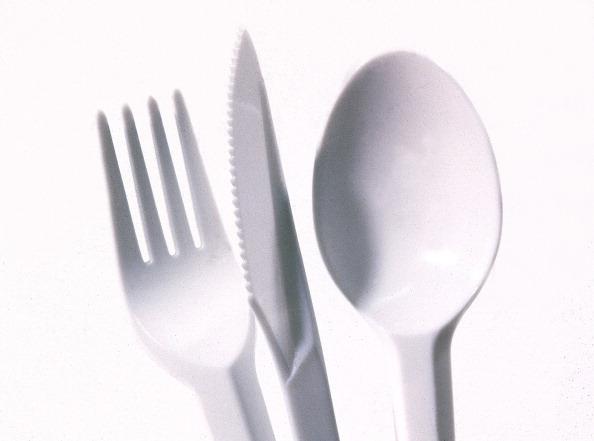When traveling to another country, a lot of us are utterly clueless about dining etiquette and proper mannerisms. For example, when we stick our chopsticks into the rice as we wait for our next dish to be served, we wonder why nearby diners are giving us weird looks. It turns out that inserting chopsticks straight into the rice is what the Chinese and Japanese do in ceremonial offerings to the dead, so it is extremely taboo to do so when eating a meal (we don’t want to awaken any ancient spirits...). So here’s a list of some general rules to go by when you’re eating in a different country so you don’t get any strange looks or offend any natives.

Cutlery, Plastic Knife Spoon Fork. (Photo by Jeff Overs/BBC News & Current Affairs via Getty Images)
1. In Thailand, Don’t Eat With a Fork.
Forks are only used to push the food onto your spoon. It is considered bad manners to put a fork into your mouth. You should also not bring your chopstick-eating habits to this particular country. Traditional Thai dishes are eaten solely with forks and spoons, not chopsticks.
2. In the Middle East, India, and Parts of Africa, Eat With Your Right Hand Only.
People mostly eat with their hands in these regions, but it’s more common to see them use their right hands because left hands are considered dirty and used for...unclean business.

Blocks of Cheese. (Skånska Matupplevelser/flickr)
3. In Italy, Don’t Ask for Extra Cheese.
It isn’t polite to put extra cheese on your pizza or seafood. And while waiting to be served, you should place your hands on the table, not on your lap, while also making sure your elbows are off the table. In addition, you shouldn’t order a cappuccino after a meal, because Italians say that milk hinders digestion. So try an espresso or plain coffee instead.
4. In South Korea, Respect Your Elders.
Don’t start eating until the most senior person starts eating. And when an elder offers you a drink, receive it with both hands.
5. In Ghana, Eat From One Large Communal Bowl.
A wash basin is brought over for washing hands before the meal, and everyone eats with their hands (particularly the thumb and first two fingers of your right hand) from the large bowl in the center, because use of individual plates is considered wasteful. You eat from the section of the bowl closest to you; it’s considered poor manners to reach all the way to another person’s side.

(Slurping noodle Image via Shutterstock)
6. In Japan, slurping when Eating Noodles Is Encouraged.
Slurping tells the chef you enjoyed their food; it’s a compliment, not some rude gesture. To be polite, you should also gratefully receive your meal and thank the chef after you eat. Some other examples of Japanese dining etiquette include bringing your bowl of rice close to your mouth to avoid spilling any food while you eat, and not passing food from chopstick to chopstick (this occurs during funeral rituals so it is considered taboo in everyday life). When you eat sushi, dip it upside-down into the sauce, so only the fish touches the sauce. If the rice contacts the sushi, the delicious sushi flavors would be overwhelmed and lose their fine touch.
7. In El Salvador, Don’t Leave Too Quickly.
Here, you should expect lively conversation and hearty meals; in fact, it’s rude to leave too quickly. Stay and converse after you eat instead. And in contrast to Ghana, most people eat exclusively with utensils, not hands. When someone comes or leaves, it is common courtesy to stand up and shake their hands.
8. In China, Burping Is Good!
In China, everyone shares food from communal plates, which are often placed on rotating trays and round tables for easy sharing, and you should always serve others before you serve yourself. Burping after you eat is actually a compliment to the chef, which indicates you liked the food a lot. Some do not’s are filling your own glass (be polite and fill others’ instead!), finishing all your food (it suggests the chef didn’t feed you enough), flipping a fish (there’s an old superstition that one flipped fish equates to one capsized boat), using chopsticks to point or bang on the table, and digging through your food to find something. And finally, when paying the check, you should eagerly offer to pay the whole bill. In fact, many large parties at Chinese restaurants often get into huge arguments over who will pay the bill!
9. In India, Eat With Your Hands.
Wash your hands before and after eating. To be respectful, allow the eldest person to be seated first and wait for him or her to start eating before you do. During the meal, use your right hand to scoop up food. Flatbreads are provided to help you pick up the food as well. If you really want to use utensils though, they'll be made available to you. And don’t waste food! It’s quite disrespectful!
10. In France, Don’t Eat Bread as an Appetizer.
Bread isn’t something to eat before the main course; it’s supposed to be eaten with the main dish, helping you bring the food to your fork. You should tear off a piece of bread rather than bite directly into it, and you should place it on the table, rather than on the plate, when you aren’t eating. At the end of the meal, don’t split the bill (a sign of lack of sophistication); instead, offer to pay the entire bill, or let someone else pay.






